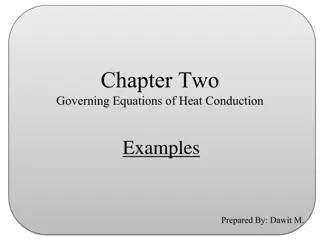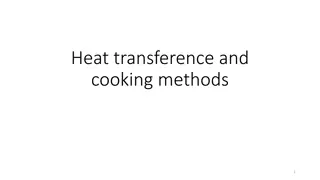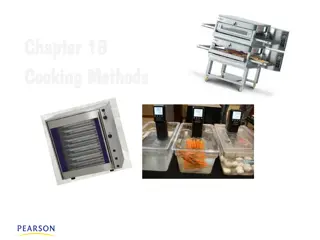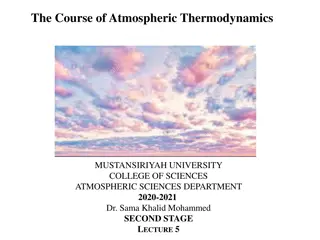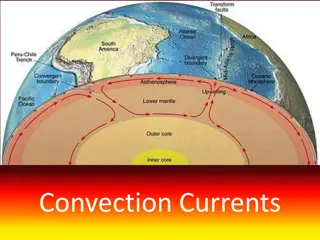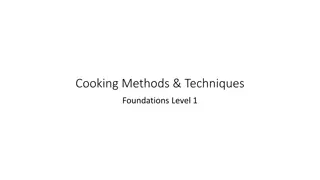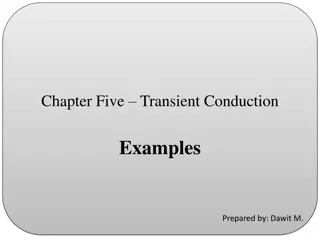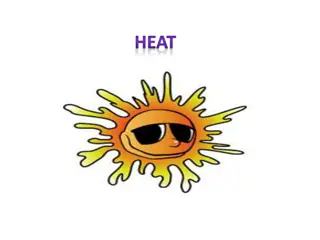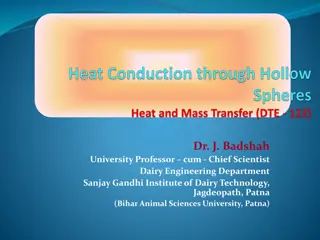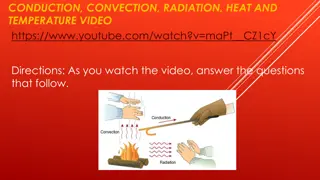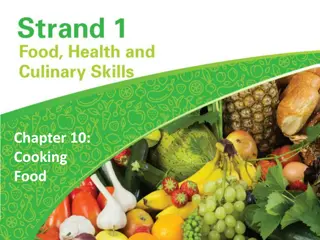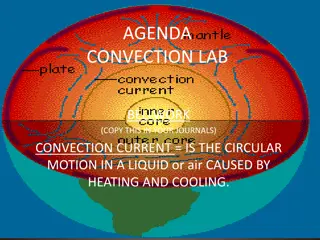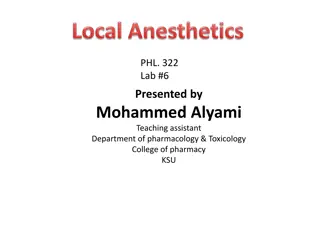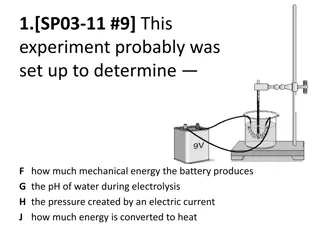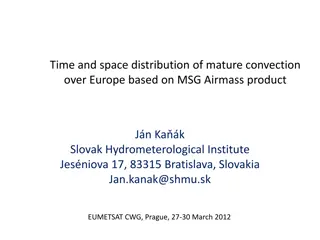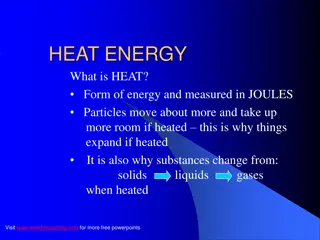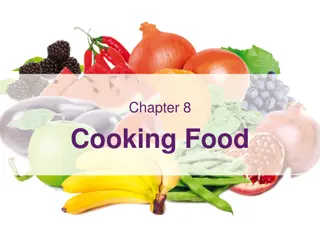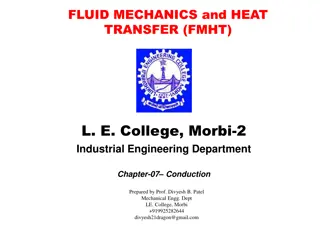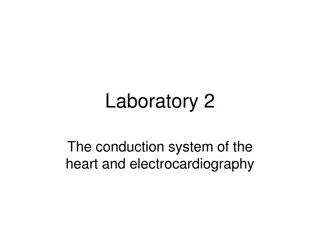Understanding Cooking Methods: Conduction and Convection Explained
Cooking methods like conduction and convection are fundamental in culinary arts. Conduction involves direct heat transfer through matter, while convection utilizes the movement of fluids for heat transfer. Gravity and buoyancy play crucial roles in natural convection processes, resulting in efficient cooking techniques.
Download Presentation

Please find below an Image/Link to download the presentation.
The content on the website is provided AS IS for your information and personal use only. It may not be sold, licensed, or shared on other websites without obtaining consent from the author. Download presentation by click this link. If you encounter any issues during the download, it is possible that the publisher has removed the file from their server.
E N D
Presentation Transcript
METHODS OF COOKING METHODS OF COOKING PRESENTED BY PROF. VIJENDER NOONWAL DEPT OF HMCT
INTRODUCTION TO COOKING METHODS There are three methods of cooking: Conduction, Convection and Radiation
INTRODUCTION TO COOKING METHODS Conduction is a method in which the heat is passed from the objects directly, Convection is a method in which, the gases and any liquid is heated with the help of object, Radiation is the transfer of energy with electromagnetic waves. the help of
DEFINITION OF CONDUCTION Conduction can be understood as the process, which enables direct transfer of heat through the matter, due to the difference in temperature, adjacent parts of the object. It happens temperature of the molecules present in a substance increase, resulting in vigorous vibration. between when the
DEFINITION OF CONDUCTION The surrounding molecules, making them vibrate too, resulting in the transportation of thermal energy to neighbouring part of the object. molecules collide with
DEFINITION OF CONDUCTION In simple terms, whenever two objects are in direct contact with one another, there will be a transfer of heat from the hotter object to the colder one, which is due to conduction. Further, the permit heat to travel easily through them conductors. objects which are called
DEFINITION OF CONVECTION In science, Convection implies the form of heat transfer, by real movement of matter, that occurs only in fluids. Fluid alludes to any whose molecules move freely from one place to another, such as liquid and gases. It happens naturally forcefully. substance, or even
DEFINITION OF CONVECTION Gravity has a great role to play in natural convection such that when the substance below, leads to the expansion of the hotter part. Due to buoyancy, substance rises as it is less dense and the colder substance replaces it by sinking at the bottom, due to high density, which when gets hot moves upward, and the process continues. In heating up the molecules disperse apart. is heated from the hotter convection, substance, it s and on moves
DEFINITION OF CONVECTION When performed substance is compelled to move upwards physical means such as the pump.E.g.Air heating system. the convection forcefully, is the by any
DEFINITION OF RADIATION The heat transfer mechanism in which no required is called radiation. It refers to the movement of heat in waves, as it does not need molecules through. medium is to travel
DEFINITION OF RADIATION The object need not be in direct contact another to Whenever you without actually touching the object, it is radiation. Moreover, colour, orientation, etc. are some of the surface which radiation greatly with one heat. heat transmit feel because of surface properties on depends
DEFINITION OF RADIATION In this process, the energy is transmitted electromagnetic waves called as radiant energy. Hot objects thermal energy surroundings. Radiant energy is capable of travelling vacuum from its source to the cooler surroundings. The best example of radiation is solar energy that we get from the sun, even though, it is miles aways from us. through generally emit cooler in to the
DIFFERENCE BETWEEN CONDUCTION, CONVECTION & RADIATION CONDUCTION CONVECTION RADIATION Conduction is a process in which heat is transported between parts of a continuum, through direct physical contact. Convection is the principle, wherein heat is transmitted by currents in a fluid, i.e. liquid or gas. Radiation mechanism, in which the transition takes place through electromagnetic waves. is the heat transfer Conduction shows, how heat is transferred between direct contact but Convection reflects how heat travels through liquids and gases. As against this, radiation indicates how heat travels through places having no molecules. objects in Conduction takes place as a result of the difference in temperature, i.e. heat streams from high-temperature area to low temperature area. Convection happens due to the variation in density, such that the heat moves from low-density region to high-density region. On the contrary, all object release heat, having a temperature more than 0 K. Conduction usually occurs in solids, through molecular collision. Convection occurs in fluids by mass motion of molecules in the same direction. In contrast, Radiation takes place through the vacuum of space and does not heat up the intervening medium.
DIFFERENCE BETWEEN CONDUCTION, CONVECTION & RADIATION CONDUCTION CONVECTION RADIATION The transfer of heat is through heated solid substance, in conduction, whereas in convection the heat energy is transmitted by way of intermediate medium. Unlike, radiation uses electromagnetic waves to transfer heat. The speed of conduction and convection is slower than radiation. Conduction and convection do not follow the law of reflection and refraction, but radiation does.
CLASSIFICATION OF COOKING METHODS CLASSIFICATION OF COOKING METHODS
MOIST METHODS/WET METHODS BOILING SIMMERING POACHING STEWING STEAMING PRESSURE COOKING BRAISING BLANCHING
BOILING BOILING Boiling is fast and easy to control, it is done at 1000C. The secret is to use as little water as possible and avoid overcooking vitamins and retained. For vegetables broccoli, cut into equal-sized pieces. so all the are flavour such as
BOILING BOILING Add to a pan of boiling water, quickly bring back to the boil, cover, and then simmer until the vegetables are just tender. To evenly cook potatoes and other starchy roots, such as parsnips (The parsnip is a root vegetable closely related to carrot and parsley; all belong to the family Apiaceae.
BOILING BOILING It is a biennial plant usually grown as an annual. Its long, tuberous root has cream- colored skin and flesh, and, left in the ground to mature; it becomes sweeter in flavor after winter carrots, place in cold water and boil them gently to allow the heat to diffuse through the vegetables. frosts). and
ADVANTAGES ADVANTAGES It is the simplest method. It does not require special skill and equipment. Protein soluble starch can be removed and grain is separated. Protein gets denatured, starch gets gelatinized and collagens get hydrolyzed. Uniform cooking can be done.
DISADVANTAGES DISADVANTAGES Loss of nutrients- if excess water is used in cooking and water Is discarded, 30-70% of nutrients like vitamin C may be lost. Loss of colour- water soluble pigments like beetroot may be lost. Loss of flavours and texture- boiled food are can not considered tasty because flavour compound are leaches into water. Time consuming- boiling may take time and fuel may get wasted. betanins from
SIMMERING When, food is cooked in a well fitting lid at temperature just below the boiling point. The temperature of liquid is 82-90 degree C in which they are immersed the process is known as simmering. It is useful method when foods have to cook for a long time.
ADVANTAGES ADVANTAGES Food gets cooked thoroughly. Scorching or prevented. A loss due to simmering is minimum burning is
DISADVANTAGES DISADVANTAGES There is loss of heat sensitive nutrients due to long period of cooking. Takes more time and more fuel are required.
POACHING This minimum amount of liquid at temperature of 93-95 degree C that is below the boiling point. Foods generally poached are egg, fish and fruits. For poaching eggs, the addition of little salt or vinegar to cooking liquid lowers the temperature of coagulation. Eggs get cooked quickly by the process. requires cooking in
ADVANTAGES ADVANTAGES Very quick method of cooking. Easily digestible since no fat no used.
DISADVANTAGES DISADVANTAGES It is bland in taste Water soluble nutrients may be leached into water.
STEWING This is gentle method of cooking in a pan with a tight fitting lid, using small quantities of liquid to cover only half of food. The food above the liquid is cooked by steam generated within the pan. The liquid is brought to a boiling point and then the heat applied is reduced maintain the simmering temp i.e. 98 degree C. cooking at
STEWING Stewing is slow method of cooking taking from 2-4 hrs depending upon the nature and volume of food being stewed. This method is generally used for cooking cheaper cuts of meat along with some root vegetable and legumes all put in the same cooking pot and cooked in stock or water.
STEWING The larger cooking time and lower temperature enables tougher meat fibre to become soft. The cooking of meat and vegetables together to make the dish attractive nutritious since no liquid is discarded. and
ADVANTAGES Loss of nutrients by leaching does not takes place. Flavour is retained. Ex- In making oondhya vegetables are stewed by which flavour is retained.
STEAMING Steaming vegetables is the best way of retaining flavour, colour and vital nutrients. Just be careful not to overcook them as this will make them limp and tasteless.
STEAMING There are two ways to steam vegetables: either place them loosely in a steamer and cover, or to steam them in their own juices, wrap parchment or foil then cook in the oven at 180 C, gas mark 4 for 20 minutes until tender. in baking
STEAMING This last technique is ideal for delicate produce, such as asparagus vegetables. The water should be boiled before the food is placed in steamer. Here the food gets cooked at 100 degree C. and baby
TYPES OF STEAMING WET STEAMING Here the food is in direct contact with the steams. DRY STEAMING Here double broiler is used for cooking the food in a container over hot or boiling water. This process is used for such preparation as sauces and custards.
PRESSURE COOKING A relative small increase in temperature can drastically reduced cooking time and this fact is utilized in pressure cookers. In this the escaping steam is trapped and pressure so temperature of boiling water and steam can be raised above 100 degree C and reduced cooking time. kept that under the
ADVANTAGES It takes less time to cook. Different items may be cooked at same time. Fuel is saved. Requires less attention. Nutrients or flavor losses may be less. Food is cooked thoroughly by this method. There is an indication for completion of cooking. There are less chances of scorching or burning.
DISADVANTAGES Though knowledge of using the equipment is required, otherwise accidents can happen. There may be mixing of flavors. Food may be undesirably soft. Ex- of food cooked in pressure cookers are rice, dhal, vegetables, meats, etc.
BRAISING It is a combined method of roasting and stewing. Braising and techniques that, master, you ll want to use over and over again. stewing once are you
BRAISING They involve cooking ingredients slowly in flavorful liquid on a low heat, usually over several hours, and they guarantee soft, tender vegetables and meats. Once the prep is done, you can put it on the stove (or in the oven) and leave it until it s ready to eat.
BRAISING This method works best for sturdy and tough vegetables, like winter squash, root vegetables, and beans and legumes, or fibrous veggies like celery, fennel, and leeks. To add even more flavor to your vegetable dish (and to do a true braise), start by saut ing the ingredients in olive oil until lightly browned and caramelized, then add the liquids
BLANCHING Blanching is a technique used to soften vegetables, either to remove their raw edge before adding to salads or to loosen skins on foods such as tomatoes or shallots.
BLANCHING Vegetables blanched before they are frozen, as this destroys the enzymes that cause deterioration. Just add vegetables to a pan of boiling water, return to the boil and cook for one minute. Then plunge the vegetables into iced water to stop the cooking process. Drain and pat dry with kitchen paper before using or freezing. should also be
DRY HEAT METHODS DRY HEAT METHODS BROILING BAKING
BROILING BROILING It is a method in which the food is kept in a chamber and cooked in its own juices with dry heat. it is cooked at 1800C -2000C. The source of heat may be above or below. Shirred eggs (oeuf sur la plat) is an example of broiled eggs.



